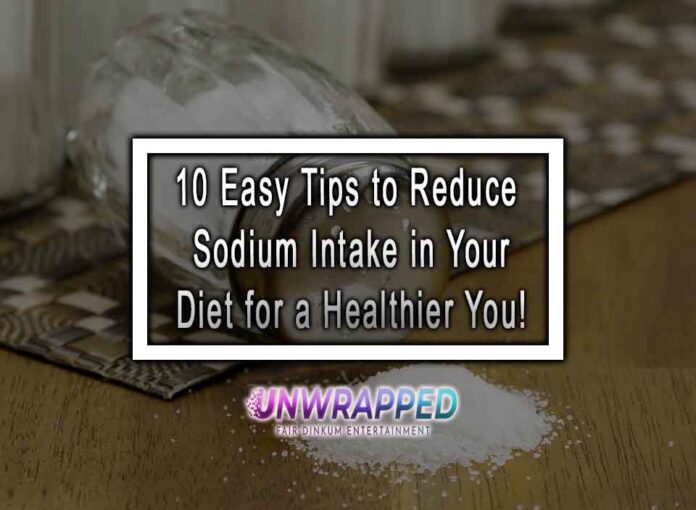10 Easy Tips for Reducing Sodium Intake in Your Diet: Embrace a Healthier Lifestyle!
Welcome to the ultimate guide on reducing sodium intake in your diet! If you’ve been feeling bloated or concerned about your sodium consumption, worry not, because we’ve got you covered. High sodium intake can lead to various health issues, such as hypertension and kidney problems. But fear not, we have ten fun and simple tips to help you cut back on the salt while still enjoying delicious meals. Say hello to a healthier you with these fantastic strategies!
1. Get Seasoned with Herbs and Spices
Who said healthy food has to be bland? Ditch the salt shaker and start experimenting with a variety of herbs and spices that add depth and complexity to your dishes. Not only do they add incredible flavors, but they also come with a plethora of health benefits. Try incorporating basil, oregano, thyme, turmeric, or cumin into your recipes for a burst of taste without the sodium overload.
2. Embrace the Citrus Zing
Citrus fruits are not just incredibly refreshing; they’re also fantastic salt substitutes. The natural tanginess and brightness of lemons, limes, and oranges can awaken your taste buds and elevate the flavors of your meals. Squeeze some lemon or lime juice onto your salads, fish, or grilled veggies, and watch how they transform into tantalizing delights without adding any sodium.
3. Go Fresh and Natural
Processed and pre-packaged foods may be convenient, but they’re often loaded with hidden sodium. Opt for fresh, natural ingredients whenever possible. Not only are fresh fruits, vegetables, and lean meats low in sodium, but they are also packed with essential nutrients that your body craves. Plus, cooking from scratch allows you to have full control over the amount of salt in your dishes.
4. Rinse and Soak Your Veggies
Canned vegetables may seem like a quick fix, but they’re often preserved in sodium-heavy brines to extend shelf life. However, you can significantly reduce their sodium content by giving them a thorough rinse or soaking them in water before cooking. This simple step ensures that you’re enjoying the nutritional benefits of vegetables without the added salt.
5. Choose Low-Sodium Alternatives
Gone are the days of compromising on taste when trying to reduce sodium intake. Nowadays, many brands offer low-sodium or no-salt-added versions of your favorite condiments, canned goods, and broths. With a little label reading, you can easily find healthier alternatives that won’t sacrifice flavor.
6. Be Wary of Sneaky Salty Snacks
Snack time can be a sodium trap! Those beloved potato chips, pretzels, and even some types of popcorn can pack a salty punch. But don’t worry, you can still satisfy your cravings without overloading on salt. Look for low-sodium or air-popped alternatives to keep your snacking game in check.
7. Hydrate, Hydrate, Hydrate
The benefits of staying hydrated go beyond quenching your thirst. Drinking enough water is essential for overall health and can help flush out excess sodium from your body. Plus, staying hydrated reduces the likelihood of mistaking thirst for hunger, preventing unnecessary salty snacks throughout the day.
8. Read Labels Like a Pro
Before tossing an item into your shopping cart, take a moment to read the nutrition label. Pay attention to the sodium content per serving and the serving size. You might be surprised to discover how quickly sodium adds up when you’re not aware. Being label-savvy empowers you to make informed decisions about the products you consume.
9. Eat Mindfully
In our fast-paced world, it’s easy to rush through meals without truly savoring the flavors. However, eating mindfully allows you to appreciate the natural tastes of food and helps you recognize when you’re full, preventing overeating salty dishes. Slow down, chew your food thoroughly, and take the time to enjoy each delicious bite.
10. Prepare Your Own Dressings and Sauces
Bottled dressings and sauces may seem convenient, but they often come with high sodium levels to enhance their taste and shelf life. Instead, create your own delicious dressings and sauces using simple ingredients like olive oil, vinegar, and an array of herbs and spices. With this approach, you’ll have total control over the ingredients and can customize flavors to suit your preferences perfectly.
Cheers to a Healthier You: Successfully Cutting Back on Sodium Intake!
Congratulations on completing our sodium-reducing journey! By incorporating these ten easy tips into your daily routine, you’ll be well on your way to a healthier lifestyle. Reducing sodium intake not only benefits your heart and kidneys but also enhances your overall well-being. So, take charge of your health, get creative in the kitchen, and enjoy the flavors of life with these low-sodium alternatives. Remember, every small change counts towards a happier, healthier you!
Explore now: Hit the Road with Health: 10 Essential Road Trip Healthy Habits!










